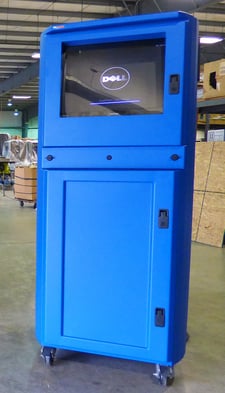Hardware performance and functionality, in general, does not vary much between companies, but there are many options and price points available.
The following steps will help manufacturers or integrators determine the ‘real cost’ of doing business with an enclosure supplier and help assist in the purchase timeline for a project.
1. Comparison Shopping
When it comes to a manufacturing or factory setting, many options exist for industrial enclosures. Before purchasing equipment, consult with other knowledgeable business partners or associates that have experience in deploying industrial enclosures. Do not make the mistake of specifying a product that will perform well below expectations.
2. Case Studies
 Experience speaks for itself! Browse the enclosure supplier’s website for current, relevant installations or case studies that may be similar to your environment. How satisfied are other clients? What problems did the enclosure solution solve? How well are the enclosures performing over time? Can you contact a company’s customer(s) for an honest critique? Invest in a solution that is built to withstand a rugged manufacturing environment.
Experience speaks for itself! Browse the enclosure supplier’s website for current, relevant installations or case studies that may be similar to your environment. How satisfied are other clients? What problems did the enclosure solution solve? How well are the enclosures performing over time? Can you contact a company’s customer(s) for an honest critique? Invest in a solution that is built to withstand a rugged manufacturing environment.
3. Hidden Costs
Buyer beware! Every company, small or large, is always looking for ways to save a few dollars. Upon receiving the initial quote(s), do not assume that the best solution will be the least expensive. Consider the total cost of ownership for the enclosure system. If the computer enclosure does not come assembled, recognize the amount of time and energy that will be required to assemble each individual system. Then additionally, consider the time needed to install all of the wide-ranging electronics. Also, understand what accessories are standard versus add-ons/upcharges that will increase the overall enclosure price.
4. Customization
Prior to shipping, custom doors and knockouts (for push buttons) provided by the enclosure manufacturer will save the end user or system integrator a significant amount of time during large deployments. Pre-cut monitor doors that are built specifically for an HMI or touchscreen eliminate the need to make the cutouts on site, which, again, saves time and money. Also, consider printer access doors, bolt-down legs, sliding shelves, power supplies, locks, and rack mount rails. These are popular customization features that will enhance the enclosure functionality for the user.
5. Evaluation Unit or Prototype
In larger deployments, it is imperative that manufacturers build a prototype to ensure that the end user is ordering the right solution. Be wary of enclosure manufacturers that do not encourage this step. A quick sale - without thorough investigation - may result in the wrong solution. This could be quite costly. End users should be able to evaluate the solution prior to committing capital funds. Upon receipt of the prototype, the team will be able to determine very quickly if the solution will work for everyone’s needs. It is also important to verify the overall user friendliness. For solutions that are not completely custom, cabinet suppliers may offer an evaluation unit for a period of 30 days. The price for an evaluation unit might only be the cost of the freight to and from.
6. Warranty
Inquire with the enclosure company on the warranty. Ask a very simple question: theoretically, how long should the products last? Also, what is the process for submitting a claim if something would need to be serviced or replaced altogether? Companies that offer a limited warranty or no warranty may already know that the product that they are supplying is going to fail.
7. Think Ahead
Avoid choosing the cabinet that is the lowest price on the marketplace. The old saying still rings true, “You get what you pay for.” The cheapest product is probably the lowest price for a reason. It is vital to think at least 2-5 years into the future. Will the enclosure withstand the installation environment (harsh as it may be) and will it accommodate the future’s everchanging sizes and styles of electronics? Thermal management should also be considered if the enclosure electronics produce a large amount of heat.
8. Knowledgeable Sales/Engineers
The sales department is, most likely, the first contact a system integrator will have with an enclosure supplier. A sales rep should be friendly and willing to help design the best solution for your application. If you need help configuring a system, the rep should ask general questions to narrow down the request. For highly customized projects, ask for feedback from the skilled and experienced engineering department. Choosing an enclosure manufacturer that is willing to answer your questions knowledgeably and politely will bear the most fruit.
The best, most capable enclosure supplier should be able to provide all 8 points mentioned above. After the main project scope has been prepared, spend time familiarizing the team - that is working on the project - to gather information and collectively make the best decision on an enclosure solution. Always consider variables like cost, materials, construction, and warranty before a purchasing choice is made for the deployment. The lead time for delivery should also be clearly conveyed from the first quote to the purchase order.
For More Information:
-- 8 Keys for Selecting the Proper PC Enclosure
-- Determining the Value in Computer Enclosures
-- 3 Considerations for Computer Enclosures
HAVE QUESTIONS? LET US KNOW HOW WE CAN BEST ASSIST YOU! CONTACT AN 'ITSENCLOSURES EXPERT' AT 1-800-423-9911 -OR- SEND US AN EMAIL: INFO@ITSENCLOSURES.COM



